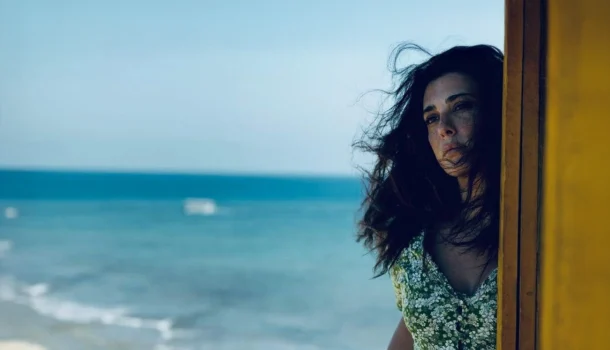The confinement of a family on a forgotten strip of land between sky and sea carries, in its apparent simplicity, the distortion of a founding idea: home as refuge. In “The Sandle Castle”, this image morphs into ritualized agony, where daily gestures — filtering water, rationing food, keeping the flame of coexistence alive — become acts of resistance against a silent unraveling. Matty Brown offers more than allegory: he stages the collapse of an emotional structure amid the total absence of horizon, dissolving the line between shelter and prison. Co-written with Hend Fakhroo and Yassmina Karajah, the screenplay operates like an atmospheric riddle, driven not by twists but by the diffuse sensation that something essential is being slowly erased, like salt eating through metal until only irreversible wear remains.
The key to this slow erosion is Jana, whose games with sandcastles and ants reveal a private language of someone left at the margins of reality. It is through her lens that the fable takes shape, establishing a childlike universe that resists the surrounding brutality through invented codes and silent fabulations. But innocence here does not shield — it exposes. The old radio she keeps as a talisman, the unmatched red shoe, the buried chest that seems to hold unspeakable memories: all pulse as clues from a displaced world, where answers are forever deferred. Jeremy Snell’s vibrant cinematography heightens this tension by contrasting visual lyricism with the weight of physical and emotional isolation, crafting an aesthetic of dissonance.
By steering away from overt depictions of trauma, Brown leans into the density of symbols and the gradual decay of bodies — especially that of Nabil, played by Ziad Bakri, whose fixation on repairing the lighthouse teeters between delusion and instinct. The lighthouse, a literal stand-in for guidance amid darkness, soon proves futile, just like the inherited protocols of a bygone life. Every gesture from Nabil, every silence from the mother (played by Riman Al Rafeea), echoes the futile attempt to protect their children from a shipwreck that has already happened. The film does not scream — it suggests — until the viewer realizes they’re witnessing a harrowing portrayal of what politics dehumanizes: involuntary exile, disrupted childhood, forbidden belonging.
When the veil finally lifts and reveals what was just out of frame all along, “The Sandle Castle” ceases to be a mere story of four people on an island. It becomes a cry against indifference, a poignant evocation of the stories silenced by geopolitics and the comfortable distance of those who merely watch. Brown, Fakhroo, and Karajah do not assign blame or offer solutions — they sculpt emptiness with minimal gestures and a tenderness that, precisely because it isn’t obvious, becomes all the more devastating. Jana, adrift in her world of sand and static, does not fully grasp the tragedy she is submerged in. And it is precisely this incomprehension that powerfully lays bare the scale of the disaster.
In a time when the world’s noise tends to drown out the essential, the film chooses the opposite: silence, waiting, repetition. With every failed attempt to tune the radio, every sandcastle swallowed by the sea, lies the reflection of millions of lives caught between hope and despair, without audience or relief. The lighthouse — the quintessential symbol of direction — remains lit, but no one seems to notice. And that forgotten, persistent, useless light may be the most accurate image of a planet that keeps spinning, while many, like Jana, remain stranded in places no voice ever reaches.
Film: The Sandle Castle
Director: Matty Brown
Year: 2024
Genres: Drama/Fantasy/Mystery
Rating: 9/10

